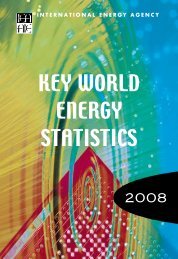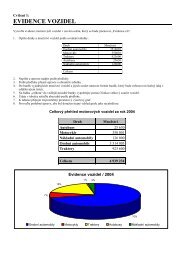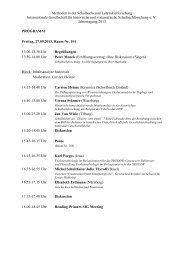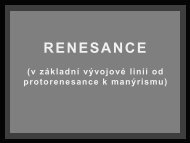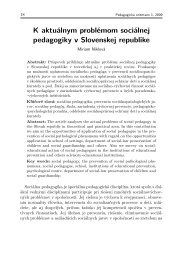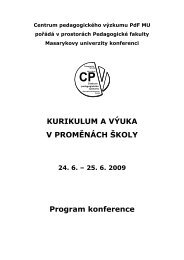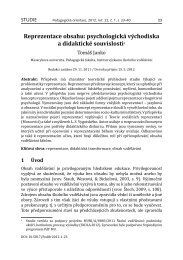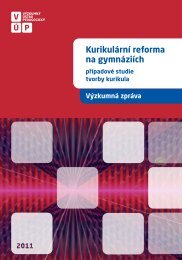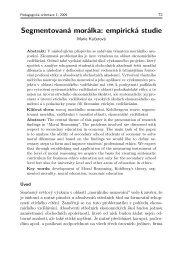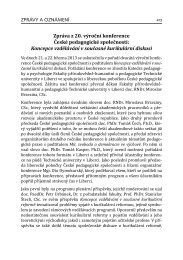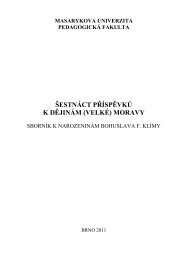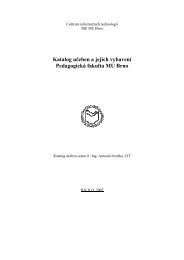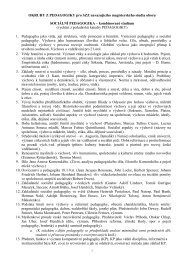Bytheway - Pedagogická fakulta MU - Masarykova univerzita
Bytheway - Pedagogická fakulta MU - Masarykova univerzita
Bytheway - Pedagogická fakulta MU - Masarykova univerzita
You also want an ePaper? Increase the reach of your titles
YUMPU automatically turns print PDFs into web optimized ePapers that Google loves.
O INTRO<br />
Y KENNETH G. HAY<br />
audience or in any mode of reception (as I shall call it) that<br />
fi nds itself presented with works of originality occur because:<br />
We are to think of the products of genius and<br />
originality as something that makes sense in a new way,<br />
or simply as making new sense. The relation of originality<br />
to its audience is to be investigated as the relation of<br />
the capacity for making new sense to the capacity for<br />
following such sense. 16<br />
Insofar as artists-as-researchers invent new types of<br />
knowledge, never seen before, they hit upon a paradox: For<br />
their creations to be considered art by their audience, they have<br />
to conform to certain pre-agreed (a priori) criteria. Insofar as<br />
their creations are genuinely new (and therefore not previously<br />
conceptualised) they become more or less unintelligible (as art)<br />
to that audience.<br />
Likewise for Kant, originality was the primary property of<br />
genius; totally opposed to the spirit of imitation. Genius is seen<br />
as an intervention by Nature into human affairs. It starts or exists<br />
outside of our daily life, which for Kant is bound up with and<br />
structured by rules. Genius is thus the way to a new rule.<br />
It may be seen that genius is a talent for producing<br />
that which no defi nite rule can be given: and not an<br />
aptitude in the way of cleverness for what can be learned<br />
according to some rule; and consequently, originality<br />
must be its primary property.<br />
One of the issues confronting all art publics, including<br />
appraising bodies and research boards, is how to distinguish<br />
between genuinely innovative art (which contributes to<br />
knowledge) and nonsense (which does not). As Kant says:<br />
Since there may also be original nonsense, its products<br />
must at the same time be models; i.e. be exemplary;<br />
and consequently, though not themselves derived from<br />
imitation; they must serve that purpose for others, i.e. as<br />
a standard rule of estimating. 17<br />
Works of genius/originality serve both to break existing rules,<br />
and to constitute new rules through which art (and knowledge)<br />
advances. Originality in art is then, by its nature, thinking outside<br />
the box into which convention or tradition tries to place it.<br />
A further paradox which Kant observes follows from the<br />
observation that products of genius are fi rst and foremost<br />
original. Genius is diametrically opposed to imitation, and yet,<br />
for its products to be accepted as art, they must serve as the<br />
standard for new types of imitation.<br />
Ted Cohen reminds us that this quality of saying something<br />
truly new by utilising the existing is one of the defi ning<br />
characteristics of metaphor:<br />
Seen in this way, a metaphor may be the best<br />
available example of what Kant called products of<br />
genius – Genius, according to Kant, is the capacity to<br />
produce things which are ‘original’ and hence things<br />
16 Timothy Gould, The Audience of originality: Kant and Wordsworth on the<br />
reception of Genius’, in Essays in Kant’s Aesthetics, ed. Ted Cohen & Paul<br />
Guyer, University of Chicago Press, Chicago & London, 1982, 85, (pp.179-<br />
193), p. 180.<br />
17 I. Kant, op.cit., §46, sections 307-8, pp. 168-9.<br />
which cannot be made sense of by means of any rules<br />
of explication, but which nevertheless do make sense 18<br />
(a new sense).<br />
Works of genius make (new) sense; but because this sense<br />
is new, its audience has not (yet) been able to understand it<br />
(using the old rules).<br />
On this account, the connection between the work<br />
and its reception by others is at least as intimate and as<br />
hard to elucidate as the connection between somebody’s<br />
making sense and somebody’s following it. 19<br />
Precisely herein lies the value and the risk that mark the<br />
possibility of original work.<br />
The thirst which inspired our wine-taster above, engenders<br />
what Dennett has termed an epistemic hunger for a conceptual<br />
basis of aesthetic judgment, and it may well be that the object<br />
of our hunger is, for now, unpalatable to us, because it is in<br />
process of redefi ning our taste.<br />
The effort to go beyond the existing rules and produce<br />
something which cannot be made sense of by the old<br />
rules, still presents itself as making sense. 20<br />
This is received initially as an affront to our ordinary capacities<br />
for sense, but it obliges us to expand these to accommodate<br />
the new knowledge which it brings.<br />
On this showing the product of genius…is an example,<br />
not for imitation (for tha3t would mean the loss of the<br />
element of genius and just the very soul of the work) but<br />
to be followed by another genius – one whom it arouses<br />
to a sense of his own originality in putting freedom from<br />
the constraint of rules so into force in his art, that for art<br />
itself a new rule is won – which is what shows a talent<br />
to be exemplary. 21<br />
It is, I would argue, precisely this delivery of the apparently<br />
unpalatable to our (perhaps jaded) sensibilities which prevents<br />
our taste from reifying. Herein lies the value of studio practice-as<br />
research: by obliging us to think outside the box, our knowledge<br />
is expanded and, by the way, our cultural life is reanimated.<br />
18 Ted Cohen, Figurative Speech and Figurative Acts, in Journal of Philosophy,<br />
79, no. 19, November 6, 1975; p. 671.<br />
19 Timothy Gould, op.cit., p. 184.<br />
20 Ibid., p. 186.<br />
21 Kant, op.cit. §49, section 318.<br />
TEXTY_01_VESMIRY_finale.indd 9 30.3.2009 23:05:41<br />
9 P



